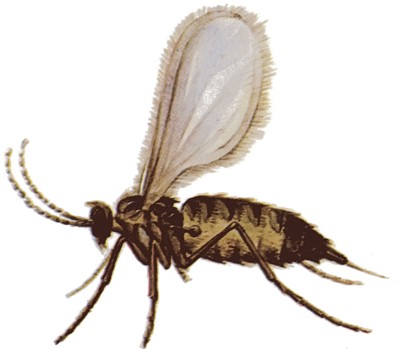Pests
Contarinia medicaginis Kieffer. - Lucerne Flower Midge, Lucerne Blossom Gallfly
Systematic position.
Class Insecta, order Diptera, family Cecidomyiidae, subfamily Cecidomyiinae, genus Contarinia.Biological group.
Monophagous pest of alfalfa.Morphology and biology.
The midge body is yellow, 1.8 to 2.3 mm in length; head and thorax dark gray. Antenna has two basal coalescent segments and 12 segments of flagellum. These segments consist of 2 nodules (spherical and ellipsoid) and 2 peduncles in male. The flagellar segments in female have one cylindrical nodule narrowing at the middle and 2 rather short peduncles. Wings are transparent, haired, forming a drawing. Radial vein R4+5 flows to wing border at apex. Each abdominal segment has transverse dorsal stripes, Tergit X is bilobate. Telescopic ovipositor is very thin, with fused lamellae. Claws of tarsus are simple. Empodium is well developed. Eggs are white at-first, then yellow, oblong, 1.8 to 2.4 mm in length, larvae are about 1.5-2 mm long. Pupa and cocoon are white. Overwintering takes place at the stage of larva in puparium covered usually with cocoon, in the ground (at a depth of 3-5 cm). In spring, the insects leave the puparium and cocoon; they become inactive (prepupae) during 36-45 days; pupa develops for 4-6 days. The midges of overwintered generation begin to fly at mass bud formation and beginning of blossoming in alfalfa, which occurs in the second half of May and the beginning of June in the zone of strong harming activity of the pest. Coupling takes place some hours after the flying-out. That same day, females lay eggs into green buds of alfalfa, piercing them by ovipositor. Fecundity of one female is about 50-70 eggs; it populates 12-15 flower buds. Embryonal development lasts 4-11 days. Larvae deform flowers at feeding. As a result, corona and staminal columns overgrow, pistil perishes. The flower becomes swollen, forming a gall. From 7 to 70 larvae develop in one gall. Larval period lasts about 10-12 days. Larvae finish their feeding, leave the flower, and fall to the ground where they pupate in 10 days. This generation is characterized by pupation in a puparium that is not covered with the cocoon. Some part of the population diapauses (without pupation) and winters. The pupa develops during 2-4 days. Life span of the insect is about 26-39 days. Flight of the second generation imagoes is observed at the second half of June, the flight of the third generation midges occurs in the 2nd-3rd thirds of July, and the flight of the fourth generation imagoes is in the 2nd-3rd thirds of August.Distribution.
The species is distibuted in Europe and Asia. Within the territory of the Former USSR, the species occurs in the zone of alfalfa growing. The northernmost part of its area is located in the Baltic States. Its highest harming activity is recorded in the forest and forest-steppe zones of Ukraine, in the forest-steppe zone of Russia (the European part and the Middle Ural), and in Moldova.Ecology.
The insect pupation is observed at the daily temperature 9.5°C, maximum 15-16°C. The optimal humidity is 60-70%, not less than 40%. When the sum of effective temperatures (degree days, or DD) reaches 230°C, and soil humidity is favorable, then the midge begins flying. The flight is more active at the DD 250°C. The most favorable conditions for the phytophage are the temperature 20-22°C and relative humidity 70-80%. Sufficient soil moisture and moderate precipitations are also important. The pest gives 2-4 generations during a year. Most important entomophages are Systasis encyrtoides Wlk., Inostemma panici Sel., Eupelmus alboannellatus Bel.Economic significance.
The species is a monophage. It damages flower buds of alfalfa. The affected flowers do not produce seeds. In the zone of strong harming activity, the Lucerne Flower Midge systematically destroys 17 to 30%, but sometimes 85% of alfalfa flowers. Control measures include duly underwinter plowing, careful sorting of seeds, crop rotations, insecticide treatments in May - June.Reference citations:
Karavyanskii N.S., Mazur O.P. 1975. Pests and diseases of fodder cultures. Moscow: Rossel'khozizdat. p. 39 (in Russian).Kolomoets T.P., Turaev N.S. 1977. Morphological and biological features of gall midges, inhabiting Fabaceae in Ural and neighboring regions of West Siberia and Kazakhstan. In: Turaev N.S, ed. Insect pests of Fabaceae plants in Ural. Proceedings of Sverdlovsk agricultural institute. Vol. 46. Perm': Perm' agricultural institute. 69-132 p. (in Russian).
Kralovich Ya. 1960. Alfalfa protection against lucerne flower midge. International agricultural journal 4: 36-44 (in Russian).
Kral'ovich Ya. 1962. The influence of humidity on lucerne flower midge Contarinia medicaginis Kieff. pupation. In: Kryshtal'A.F., ed. Problems of ecology. Proceedings of Kiev university. Moscow: Vysshaya shkola. p. 87 (in Russian).
Mamaev B.M. 1967. Family Cecidomyiidae - midges. In: Bei-Bienko G.Ya., ed. Keys to insects of the European part of the USSR. V. 5(1). Moscow & Leningrad: Nauka. P. 411 (in Russian).
Ruban M.B., Vigera S.M. & Shelikhov A.G. 1986. Basis for protection measures against lucerne flower midge at intensification of alfalfa seed production in Ukraine. In: Lisovoi M.P., ed. Plant protection. Republican thematic scientific proceedings, N 34. Kiev: Urozhai. 13-16 p. (in Russian).
Ruban M.B., Roiko N.L., Vigera S.M., Goncharenko O.I., Roik D.A. 1986. Lucerne flower midge and control measures. In: Peresypkin V.F., Kirik N.N., ed. Agricultural plants protection against pests and diseases. Proceedings of Ukrainian agricultural Academy. Kiev: Ukrainian SKhA. 34-39 p. (in Russian).
Shuster M.M., Krisachenko V.S. 1980. Forecasting lucerne flower midge. Zashchita rastenii 7: 38 (in Russian).
Sobol' G.E. 1951. Lucerne flower midge (Contarinia medicaginis Kieff.) and control measures. In: Koshik A.K., ed. Mass outbreaks of animals and their forecasting. Proceedings of second ecological conference (Kiev, 1950), vol. 3. Kiev: Ukrainian University. 220-222 p. (in Russian).
Vasil.ev V.P., ed. 1973. Pests of agricultural crops and forest plantations. 1. Kiev: Urozhai. 513 p. (in Russian).


